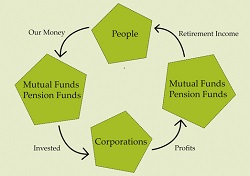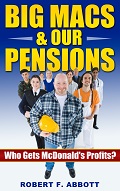|
People, Profits, & Pensions |
|
The Making of the Modern McDonald'sAn excerpt from Big Macs & Our Pensions: Who Gets McDonald's Profits? the book that explains the connection between the retirement income of the middle class and the profits of big business Wednesday, April 9, 2014
Henry Ford, you will recall, introduced the modern assembly line at his Detroit car factory in 1913. Productivity shot up when Ford introduced the line, and it quickly became the standard for manufacturing of all types of goods. 35 years later, in 1948, the McDonald brothers brought the same thinking to restaurants. They temporarily closed their doors, and began to renovate. The restaurant reopened with a radically slimmed menu: rather than the traditional array of breakfast, lunch, and dinner selections, diners had to choose from just a handful of items, including burgers, fries, and drinks. What’s more, customers could eat everything on the menu with just their fingers. In the cooking area, unskilled production workers replaced skilled short-order cooks, just as unskilled laborers replaced skilled mechanics in car building. One person cooked burgers, and burgers only, while another specialized in french fries, and so on. The art of cooking also disappeared, as each worker rigidly followed a set of instructions for his or her area. Beyond the kitchen, staff no longer went out to cars. Instead, every customer had to come inside and stand at a cash register to place an order. When their orders arrived, customers found their food wrapped in paper. No more dishes, no more cutlery. And at the new McDonald’s customers found no tables, counters, or chairs; they had to eat everything outside the restaurant. At the same time, the McDonalds allowed customers to see right into the kitchen, to see their food being prepared. That neatly tied into the brothers’ obsession with cleanliness. The kitchen always remained clean, a characteristic the company and corporation maintained as they grew from one location to more than 34-thousand. Customers gave up selection and service; instead they got fast and cheap, with orders assembled and placed in front of them in literally a minute. What was the price? Diners got a burger for 15 cents, about half the usual price, and corresponding prices for the other menu items. They loved it! End of excerpt -Big Macs & Our Pensions: Who Gets McDonald's Profits? is available at Amazon.com. The Bigger Picture:Will Profits from Big Macs Add to Your Retirement Income?In 1948, the McDonald brothers redesigned and remodelled their drive-in restaurant in San Bernardino, California. Taking inspiration from Henry Ford's assembly-line, they created the fast food revolution, with the quick service and low prices we now take for granted. In that same year, the U.S. National Labor Relations Board ruled unions could include pension issues in contract negotiations. That ignited a massive expansion of pension plans. In the 1950s, pension funds started buying stocks, rather than just bonds or their equivalents; in addition mutual funds came of age. With these two developments working, middle class people became owners of big business. At first, their stakes were modest, but steadily growing. And in just a few decades, they gained controlling interests in many large corporations through their funds. Management guru Peter Drucker has called it, "...one of the most startling power shifts in economic history." Now, working people reap the benefits of those investments, collecting much of the profit distributed by McDonald's and other big corporations. Discover how the pieces fit together. In Big Macs & Our Pensions: Who Gets McDonald's Profits? - a new booklet -(about 25-pages), you will:
You may not be among the owners of McDonald's. But if you belong to any pension plan, or contribute to a mutual fund or whole life insurance policy, you likely own pieces of some big corporations. More importantly, though, your retirement income will be bigger and grow more dependably than you would otherwise expect. Big Macs & Our Pensions: Who Gets McDonald's Profits? is now available at Amazon.com |

The Ownership Cycle
Copyright 2014. Robert F. Abbott, All Rights
Reserved.
|

 They [Dick and Maurice McDonald] built the new model on what they called the Speedee Service
System. While the earlier McDonald’s operation reflected the automobile driving revolution, Speedee reflected
the manufacturing revolution that led to mass production of cars on assembly lines.
They [Dick and Maurice McDonald] built the new model on what they called the Speedee Service
System. While the earlier McDonald’s operation reflected the automobile driving revolution, Speedee reflected
the manufacturing revolution that led to mass production of cars on assembly lines.